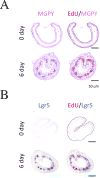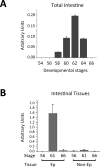The Sox transcriptional factors: Functions during intestinal development in vertebrates
- PMID: 27567710
- PMCID: PMC5326606
- DOI: 10.1016/j.semcdb.2016.08.022
The Sox transcriptional factors: Functions during intestinal development in vertebrates
Abstract
The intestine has long been studied as a model for adult stem cells due to the life-long self-renewal of the intestinal epithelium through the proliferation of the adult intestinal stem cells. Recent evidence suggests that the formation of adult intestinal stem cells in mammals takes place during the thyroid hormone-dependent neonatal period, also known as postembryonic development, which resembles intestinal remodeling during frog metamorphosis. Studies on the metamorphosis in Xenopus laevis have revealed that many members of the Sox family, a large family of DNA binding transcription factors, are upregulated in the intestinal epithelium during the formation and/or proliferation of the intestinal stem cells. Similarly, a number of Sox genes have been implicated in intestinal development and pathogenesis in mammals. Futures studies are needed to determine the expression and potential involvement of this important gene family in the development of the adult intestinal stem cells. These include the analyses of the expression and regulation of these and other Sox genes during postembryonic development in mammals as well as functional investigations in both mammals and amphibians by using the recently developed gene knockout technologies.
Keywords: Intestine; Metamorphosis; Postembryonic development; Sox genes; Stem cells; Thyroid hormone; Thyroid hormone receptor; Xenopus.
Published by Elsevier Ltd.
Figures





Similar articles
-
Spatio-temporal expression profile of stem cell-associated gene LGR5 in the intestine during thyroid hormone-dependent metamorphosis in Xenopus laevis.PLoS One. 2010 Oct 22;5(10):e13605. doi: 10.1371/journal.pone.0013605. PLoS One. 2010. PMID: 21042589 Free PMC article.
-
Thyroid hormone regulation of adult intestinal stem cells: Implications on intestinal development and homeostasis.Rev Endocr Metab Disord. 2016 Dec;17(4):559-569. doi: 10.1007/s11154-016-9380-1. Rev Endocr Metab Disord. 2016. PMID: 27554108 Review.
-
Thyroid hormone regulation of adult intestinal stem cell development: mechanisms and evolutionary conservations.Int J Biol Sci. 2012;8(8):1217-24. doi: 10.7150/ijbs.5109. Epub 2012 Oct 23. Int J Biol Sci. 2012. PMID: 23136549 Free PMC article. Review.
-
Analysis of Thyroid Hormone Receptor α-Knockout Tadpoles Reveals That the Activation of Cell Cycle Program Is Involved in Thyroid Hormone-Induced Larval Epithelial Cell Death and Adult Intestinal Stem Cell Development During Xenopus tropicalis Metamorphosis.Thyroid. 2021 Jan;31(1):128-142. doi: 10.1089/thy.2020.0022. Epub 2020 Jul 1. Thyroid. 2021. PMID: 32515287 Free PMC article.
-
Direct Activation of Amidohydrolase Domain-Containing 1 Gene by Thyroid Hormone Implicates a Role in the Formation of Adult Intestinal Stem Cells During Xenopus Metamorphosis.Endocrinology. 2015 Sep;156(9):3381-93. doi: 10.1210/en.2015-1190. Epub 2015 Jun 18. Endocrinology. 2015. PMID: 26086244 Free PMC article.
Cited by
-
Genome wide identification, phylogeny, and synteny analysis of sox gene family in common carp (Cyprinus carpio).Biotechnol Rep (Amst). 2021 Mar 16;30:e00607. doi: 10.1016/j.btre.2021.e00607. eCollection 2021 Jun. Biotechnol Rep (Amst). 2021. PMID: 33936955 Free PMC article.
-
Identification, molecular characterization and analysis of the expression pattern of SoxF subgroup genes the Yellow River carp, Cyprinus carpio.J Genet. 2018 Mar;97(1):157-172. J Genet. 2018. PMID: 29666335
-
Inhibition of TDP43-Mediated SNHG12-miR-195-SOX5 Feedback Loop Impeded Malignant Biological Behaviors of Glioma Cells.Mol Ther Nucleic Acids. 2018 Mar 2;10:142-158. doi: 10.1016/j.omtn.2017.12.001. Epub 2017 Dec 8. Mol Ther Nucleic Acids. 2018. PMID: 29499929 Free PMC article.
-
MicroRNA-138 inhibits SOX12 expression and the proliferation, invasion and migration of ovarian cancer cells.Exp Ther Med. 2018 Sep;16(3):1629-1638. doi: 10.3892/etm.2018.6375. Epub 2018 Jun 29. Exp Ther Med. 2018. PMID: 30186381 Free PMC article.
-
Sex-determining region Y-box protein 3 induces epithelial-mesenchymal transition in osteosarcoma cells via transcriptional activation of Snail1.J Exp Clin Cancer Res. 2017 Mar 23;36(1):46. doi: 10.1186/s13046-017-0515-3. J Exp Clin Cancer Res. 2017. PMID: 28335789 Free PMC article.
References
-
- MacDonald WC, Trier JS, Everett NB. Cell proliferation and migration in the stomach, duodenum, and rectum of man: Radioautographic studies. Gastroenterology. 1964;46:405–417. - PubMed
-
- Toner PG, Carr KE, Wyburn GM. The Digestive System: An Ultrastructural Atlas and Review. London: Butterworth; 1971.
-
- Cheng H, Leblond CP. Origin, differentiation and renewal of the four main epithelial cell types in the mouse small intestine. III. Entero-endocrine cells. Am J Anat. 1974;141(4):503–519. - PubMed
-
- Sancho E, Eduard Batlle E, Clevers H. Signaling pathways in intestinal development and cancer. Annu Rev Cell DevBiol. 2004;20:695–723. - PubMed
-
- van der Flier LG, Clevers H. Stem Cells, Self-Renewal, and Differentiation in the Intestinal Epithelium. Annu Rev Physiol. 2009;71:241–260. - PubMed
Publication types
MeSH terms
Substances
Grants and funding
LinkOut - more resources
Full Text Sources
Other Literature Sources
Miscellaneous

